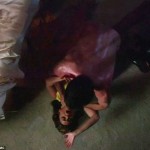Special Victims Unit has always been the black sheep of the Law & Order franchise, with a tendency towards ratings grabs with has-been guest stars and clumsy discussions of issues. With last night’s episode, “Hunting Ground”, something has definitely changed in its treatment of violence towards women.
Until recently, SVU retained the format of its parent series of being a straight, largely gimmick-free and relatively realistic police/legal procedural. Except for an opening scene in the teaser when the crime is discovered, everything is from the point of view of the detectives or the prosecutors. No flashbacks, no x-ray vision of bullets entering bodies, no “killer’s point of view” shots. There was a strict limitation on the storytelling methods available to the writers, and for the most part it worked, keeping the series away from too much melodrama, an inherent problem with this kind of subject matter.
This formal discipline created its own problems, for example, an over-dependence of dramatic confessions, not just from the perpetrators but from the the victims as well. It’s actually quite Foucauldian: sex exists as official discourse, exacted and recorded by legal and medical authorities, and getting people to talk about their sexuality, to bring their sexuality into official discourse, is the main point of the show. The show had a habit of spending a line or two of dialog on issues like gender diversity or the nature of sex work, as a gesture towards seeming thoughtful, but ultimately not thinking too deeply about things.
The story itself is a fairly standard “hunt the serial killer” plot, but what’s different from earlier such stories in this series is the use of dramatic devices that were previously never seen: cutting away from the actions of the detectives and the prosecutors to the actions of the killer and victim, both in the present and in flashbacks. I don’t know if this has changed recently or earlier, but this is a radical departure and probably not one for the better. SVU has succumbed to temptation and shifted to a more traditional treatment of women in distress: dwelling on the woman imprisoned in a cage or scrambling for survival in the wilderness, iteration who-knows-how-many of “The most dangerous game”.
In previous SVU episodes, we might see the aftermath of such Gothic torments, but we wouldn’t see them as they were happening. So, why the change? Let’s face it, live women in cages or other Insex.com-like situations are more arresting images than the suggestion of such things, with open, empty cages or dead women on autopsy tables. I can only assume that somebody in the series’ production staff changed their mind and said, “Let’s punch it up. Let’s show the victim’s suffering directly for a change.” What this means is that the show has to fall back on the same methods of the post-Silence of the Lambs serial killer melodrama/torture-porn, and this diminishes the series as a procedural, which could be (and sometimes was) an exploration of more intellectual issues of sexuality, sex work, class, and the like.
What we’ve witnessed in SVU over 13 seasons (really?) is how the discourse about violence towards women inexorably and perhaps inevitably migrates towards the melodramatic and even pornographic. The door, in effect, was already there from the series’ inception, just waiting for somebody to step through it. The producers of SVU didn’t have to step through it, but they did.
How to talk about and depict violence, and particularly violence against women and children, has been an ongoing debate in Western civilization for the past few centuries. It’s tempting to say that the progressive forces are in favour of hiding it, and reactionary forces prefer to show it, but it isn’t that simple. The “virtue in distress” figure had been used by just about every social or political cause, and just about every faction has tried to prevent that use in response. SVU‘s tilt away from procedural and towards melodrama is just another iteration of this.



